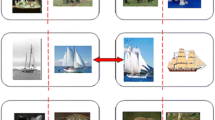Abstract
Multiple kernel learning (MKL) aims at simultaneously optimizing kernel weights while training the support vector machine (SVM) to get satisfactory classification or regression results. Recent publications and developments based on SVM have shown that by using MKL one can enhance interpretability of the decision function and improve classifier performance, which motivates researchers to explore the use of homogeneous model obtained as linear combination of various types of kernels. In this paper, we show that MKL problems can be solved efficiently by modified projection gradient method and applied for image categorization and object detection. The kernel is defined as a linear combination of feature histogram function that can measure the degree of similarity of partial correspondence between feature sets for discriminative classification, which allows recognition robust to within-class variation, pose changes, and articulation. We evaluate our proposed framework on the ETH-80 dataset for several multi-level image encodings for supervised and unsupervised object recognition and report competitive results.







Similar content being viewed by others
References
Andersen ED, Andersen KD (2000) The MOSEK interior point optimizer for linear programming: an implementation of the homogeneous algorithm. High Perf Optim 33:197–232
Aronszajn N (1950) Theory of reproducing kernels. Trans Am Math Soc 68:337–404
Bach FR (2008) Consistency of the group Lasso and multiple kernel learning. J Mach Learn Res (JMLR) 9:1179–1225
Bach FR, Lanckriet GG, Jordan M (2004) Multiple kernel learning, conic duality, and the SMO algorithm. In: Proceedings of the twenty-first international conference on machine learning, pp 775–782
Bertsekas DP (1982) Projected newton methods for optimization problems with simple constraints. J Control Optim 20(2):221–246
Biederman I, Ju G (1988) Surface vs. edge-based determinants of visual recognition. Cogn Psychol 20(1):38–64
Bosch A, Zisserman A, Munoz X (2007) Representing shape with a spatial pyramid kernel. In: Proceedings of the international conference on image video retrieval
Boyd S, Vandenberghe L (2004) Convex optimization. Cambridge University Press, Cambridge
Calamai PH, Moré JJ (1987) Projected gradients methods for linearly constrained problems. Math Program 39(1):93–116
Canu S, Grandvalet Y, Guigue V, Rakotomamonjy A (2003) SVM and kernel methods Matlab toolbox. Software avaliable at http://www.asi.insa-rouen.fr/enseignants/rakotom/toolbox/index.html
Chang CC, Lin CJ (2001) LIBSVM: a library for support vector machines. Software available at http://www.csie.ntu.edu.tw/jlin/libsvm
Chapelle O, Vapnik V, Bousquet O, Mukerjhee S (2002) Choosing multiple parameters for SVM. Mach Learn 46(1):131–159
ETH-80 dataset, avaliable at http://www.mis.informatik.tu-darmstadt.de/Research/Projects/categorization/eth80-db.htm.
Fei-Fei L, Fergus R, Perona P (2006) One-shot learning of object categories. IEEE Trans Pattern Anal Mach Intell 28(4):594–611
Fergus R, Perona P, Zisserman A (2003) Object class recognition by unsupervised scale-invariant learning. In: Proceedings of the IEEE conference on computer vision and pattern recognition, pp 264–271
Fu SY, Hou ZG, Liang ZZ, Zuo Q, Tan M, Fu XY (2008a) Unsupervised learning of categories from sets of partially matching image features for power transmission line inspection robot. In: Proceedings of the IEEE world conference on computational intelligence
Fu SY, Hou ZG, Liang ZZ, Tan M (2008b) Multiple kernel learning from sets of partially matching image features. In: Proceedings of UKACC
Grauman K, Darrell T (2005) The pyramid match kernel: discriminative classification with sets of image features. In: Proceedings of the IEEE international conference on computer vision
Grauman K, Darrell T (2006) Unsupervised learning of categories from sets of partially matching image features. In: Proceedings of the IEEE computer vision pattern recognition
Hadjidemetriou E, Grossberg M, Nayar S (2004) Multiresolution histograms and their use in recognition. IEEE Trans Pattern Anal Mach Intell 26(7):831–847
Kumar A, Sminchisescu C (2007) Support kernel machines for object recognition. In: Proceedings of the IEEE international conference on computer vision
Lanckriet G, Cristinanini N, Ghaoui EL, Bartlett P, Jordan M (2004) Learning the kernel matrix with semi-definite programming. J Mach Learn Res 5:27–72
La Torre Frade FD, Vinyals O (2007) Learning kernel expansions for image classification. In: Proceedings of the IEEE computer vision and pattern recognition
Lazebnik S, Schmid C, Ponce J (2006) Beyond bags of features: spatial pyramid matching for recognizing natural scene categories. In: Proceedings of the IEEE computer vision and pattern recognition
Lowe D (2004) Distinctive image features from scale-invariant keypoints. Proc IEEE Int J Comput Vis 60(2):91–110
Luenberger D (1984) Linear and nonlinear programming. Addison-Wesley, USA
Lv F, Nevatia R (2007) Single view human action recogntion using key pose matching and viterbi path searching. In: Proceedings of the IEEE international conference on computer vision
Rakotomamonjy A, Bach F, Canu S, Grandvalet Y (2007) More efficiency in multiple kernel learning. In: Proceedings of international conference on machine learning (ICML)
Rakotomamonjy A, Bach F, Canu S, Grandvalet Y (2008) SimpleMKL. J Mach Learn Res (JMLR) 9:2491–2521
Sonnerburg S, Raetsch G, Schaefer C, Scholkopf B (2006) Large scale multiple kernel learning. J Mach Learn Res 7:1531–1565
Wallraven C, Caputo B, Graf A (2003) Recognition with local features: the kernel recipe. In: Proceedings of the IEEE international conference on computer vision
Winter JD, Wagemans J (2004) Contour-based object identification and segmentation: stimuli, norms and data, and software tools. Behav Res Methods Instrum Comput 36(4):604–624
Acknowledgments
This work was supported in part by the National Natural Science Foundation of China (Grant 60775043). The authors also wish to acknowledge the great help and suggestions from Yan-jun Han from the key laboratory of complex system and intelligent science, Institute of Automation, Chinese Academy of Sciences.
Author information
Authors and Affiliations
Corresponding author
Appendix
Appendix
1.1 Derivation of the equivalence between Eqs. 4 and 5
Due to the relationship between \(K_m(\cdot, \cdot)\) and \(K^{\prime}_m,\) we have
The inner production of \({\mathcal{H}}^{\prime}_m,\) the RKHS induced by \(K^{\prime}_m,\) has the following form:
where \({\mathcal{H}}_m\) is induced by \(K_m,\) consider the following prime problem
then the following holds
finally, the original optimization problem in the original RKHS \({\mathcal{H}}\) take the form of
in the RKHS \({\mathcal{H}}^{\prime}_m.\)
Rights and permissions
About this article
Cite this article
Fu, SY., Yang, GS. & Hou, ZG. Image category learning and classification via optimal linear combination of multiple partially matching kernels. Soft Comput 14, 181–192 (2010). https://doi.org/10.1007/s00500-009-0436-y
Published:
Issue Date:
DOI: https://doi.org/10.1007/s00500-009-0436-y




